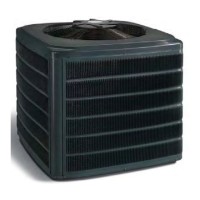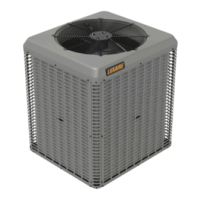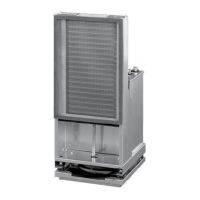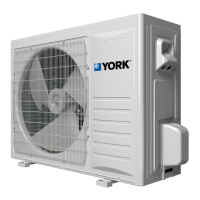40
RB SERIES ENGINEERING GUIDE
Selection Example
To achieve optimal performance, proper selection of each heat
pump is essential. A building load program should be used to
determine the heating and cooling load of each zone. A computer
software selection program can then be used to develop an
accurate and complete heat pump schedule.
While a computer software program is the easiest and most
accurate method to size and select equipment, however, selection
can still be accomplished manually using this manual and the
following selection procedure. Sizing so that the actual sensible
capacity of the equipment will satisfy the sensible capacity of the
zone is the recommended method for best results.
Boiler/Tower Application
Typical boiler/tower application will result in entering water
temperatures of 60-90°F with 70°F for heating and 90°F for cooling.
Water to refrigerant insulation option would not be required.
Flow rates are 2.5 to 3 gpm per ton with 2.5 gpm per ton often
representing an economical design point.
Geothermal Application
Typical geothermal application can result in a wide entering
water temperature range of 30-100°F. Typically minimum heating
entering water temperatures can range from 30 to 50°F depending
upon loop type and geographical location. Cooling performance
should be calculated using a maximum loop temperature of 100°F
in most loop applications. Water flow is typically 2.5 to 3 gpm per
ton with 3 gpm per ton recommended with the more extreme loop
temperatures. PLEASE NOTE THAT WATER COIL INSULATION
OPTION SHOULD BE SELECTED WHEN ENTERING WATER
TEMPERATURES ARE EXPECTED TO BE BELOW 45-50°F.
Geothermal Selection Example
Step 1: Determine the actual heating and cooling loads at the
desired dry bulb and wet bulb conditions.
Step 2: Obtain the following design parameters: Entering water
temperature, water flow rate in gpm, airflow in cfm, water flow
pressure drop and design wet and dry bulb temperatures. Airflow,
cfm, should be between 300 and 450 cfm per ton. Unit water
pressure drop should be kept as close as possible to each other to
make water balancing easier. Go to the appropriate tables and find
the proper indicated water flow and water temperature.
Step 3: Select a unit based on total and sensible cooling
conditions. Select a unit which is closest to, but no larger than, the
actual cooling load.
Step 4: Enter tables at the design water flow and water
temperature. Read the total and sensible cooling capacities
(NOTE: interpolation is permissible, extrapolation is not).
Step 5: Read the heating capacity. If it exceeds the design criteria
it is acceptable. It is quite normal for water source heat pumps to
be selected on cooling capacity only since the heating output is
usually greater than the cooling capacity.
Step 6: Determine the correction factors associated with the
variable factors of dry bulb and wet bulb.
Corrected Total Cooling = tabulated total cooling x wet
bulb correction.
Corrected Sensible Cooling = tabulated sensible cooling x wet/dry
bulb correction.
Step 7: Compare the corrected capacities to the load
requirements. Normally if the capacities are within 10% of the
loads, the equipment is acceptable. It is better to undersize than
oversize, as undersizing improves humidity control, reduces sound
levels and extends the life of the equipment.
Step 8: When complete, calculate water temperature rise and
assess the selection. If the units selected are not within 10% of the
load calculations, then review what effect changing the gpm, water
temperature and/or airflow and air temperature would have on the
corrected capacities. If the desired capacity cannot be achieved,
select the next larger or smaller unit and repeat the procedure.
Remember, when in doubt, undersize slightly for best performance.
Example Equipment Selection - Cooling
1. Load Determination:
Assume we have determined that the appropriate cooling load at the
desired dry bulb 80°F and wet bulb 65°F conditions is as follows:
Total Cooling ..............................................................51,500 Btu/h
Sensible Cooling........................................................34,300 Btu/h
Entering Air Temp ..........................75°F Dry Bulb / 65°F Wet Bulb
2. Design Conditions:
Similarly, we have also obtained the following design parameters:
Entering Water Temp ..............................................................90°F
Water Flow (Based upon 10°F rise in temp.) 15.0 gpm
Airflow Required ...................................... 1,750 cfm @ 0.2 in. wg.
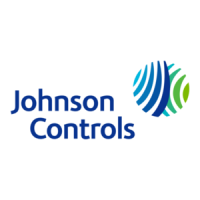
